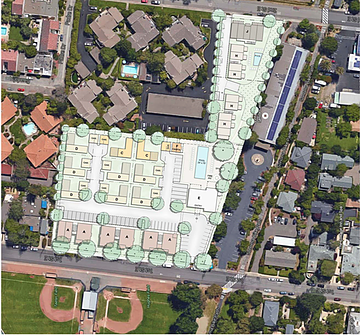Sonoma’s Planning Commission gave the First Street East project, combining housing, hotel, cafe and swim club, a gentle nod of “approval” last night at the second study session held to review the proposal. The developer, Caymus Capital, revised their original proposal which the commission had previously determined required too many variances and exceptions to planning codes. This new proposal increased the number of homes, decreased the number of hotel rooms, made the cafe smaller and reduced building heights.
The developer presented a 10-minute video explaining their view of the project, its benefits and features. The project architect spoke for a few minutes to reiterate some points in the video and to highlight design intentions.
Twenty-nine members of the public spoke to the commission, expressing a wide range of opinions and views both against and in support of the project. Eleven were generally in favor, and the balance generally opposed.
Opposition focused mostly on continuing concerns about the massing of buildings, traffic generation, and the hotel use. Larry Barnett, former Mayor, spoke first and focused his comments on the history of the parcel in question and noted that this particular piece of land had been the subject of a lawsuit and subsequent action by the City Council in 1996. At that time, he noted, the city passed an ordinance amending the then “interim zoning ordinance” with language intended to prevent commercial uses from dominating the parcel. He called this action “a promise to the neighborhood” and urged the commission to familiarize itself with that history.
Among opponents, Barnett was followed by Regina Baker, who expressed concerns about sewer overflows; Ned Forrest, who called the hotel and cafe “inappropriate”; Sam Taylor (of the North of the Mission Assn.) who noted association concerns about heights, hotel use, parking and traffic; Andrew Wilson, employed in the hotel industry, noted that in addition to autos, traffic associated with a hotel includes daily, weekly and as-needed deliveries and service by multiple food suppliers, linens, trash, repairs, etc.; David Eichar disputed the calculations presented by the applicant for traffic generation and TOT calculations.
In addition, Richard Peters, a direct neighbor to the north of the parcel, questioned the density, heights, setbacks and internal road configurations; Pat Coleman had questions about creation of an HOA and transient activity; Leslie Whitelaw disliked the three-story buildings planned for 1st St. E and impacts on traffic; Fred Allebach called the economic assumptions “voodoo” economics and urged a true sustainability model be used; Anna Gomez disputed the water-use assumptions and noted the Sonoma’s current sewer system is already beyond legal capacity; Karin Skoogland noted that over 250 homes are in the North of the Mission Assn.; Lou Braun commented that he is in support of protecting the neighborhood; James Bohar, a land-use expert, said he was shocked and that the proposed project does not fit the neighborhood; Linda Curroto liked the changes, but said the project was in the wrong location.
Finally, Lori Winter expressed concerns about the housing becoming weekend homes; Patty Dafern said the 3-story buildings look like apartments and was concerned that the “public” pool remain available to the public in the future; and Jack Wagner expressed thoughts about the need for more smaller, lower-cost housing for workers.
Among supporters, Steven Rouse called the development “better than nothing”; Tom Henry said the hotel use is less intensive than homes; Mark Mantz liked the taxes generated and called the project “a good combination”; Ross Edwards criticized opponents who he said were only “concerned about their own backyards”; Joe Diggins said the project is “great” and that more hotels are needed; Vince Beneck said the tax revenue is good, the project creates jobs and that “traffic is part of life”; Dana Hunter commented that the developer has listened and was impressed with the changes; Bastian Scholl, noting he does not live in Sonoma due to housing cost, asked “what about my rights?”; Tony (last name hard to hear) called himself an “enthusiastic supporter” of the project; Bob Blenusa (of Vineburg) said his son plays little league and he’s never had an issue with traffic; finally, Joe Aaron said he supports the project, and offered the results of a poll he conducted.
After public comments, the commission members offered their reactions. James Cribb called the area mixed use and said it’s not just residential. He noted that there are other intense uses in the neighborhood. He criticized the existing developments adjacent to the parcel as poorly designed.
Ron Wellander said he is not “close-minded” but not whole-heartedly enthusiastic. He was not in favor of the swimming pool. He called the 3-story buildings unsympathetic to the neighbor’s, as is the internal circulation plan. He expressed concerns about the sight lines and mass of the buildings.
Chip Roberson said he liked the new direction, and called it more in-keeping with the environs. He felt the heights and mass remain an issue and out of proportion. He called the idea of the hotel “not objectionable” and that mixed use makes sense if “light enough” in the neighborhood. He felt the public pool has value.
Michael Coleman noted that changes were made. He asked that the 3-story buildings be “softened” to lessen impacts. He wondered what a B&B would be like and called in-fill development positive. “Change is a way of life” he commented, and that compromise is necessary.
Robert MacDonald said he supports in-fill development. He felt that the hotel should perhaps be reduced in size. He liked the idea of creating an active street-frontage, and suggested the cafe be moved back to its location street-side. He expressed concerns about the internal circulation, noting that the entry will become too congested and become a bottleneck. He called the single family homes “bleak” in design, too auto-oriented and subject to privacy issues. Finally, he noted potential on-site drainage problems and proximity of the large oak trees planned for retention to the largest of two swimming pools.
Robert Felder, Chair of the commission, spoke last and noted that there are few large parcels in Sonoma designated as Housing Opportunity sites. He is concerned about giving up this parcel for other than housing use. He is resistant to the hotel use, but noted that in any event it is still too large. He called the 3-story units out of context and said they should be eliminated. Finally, he advocated that the affordable units in the project should not be clustered together but spread instead.
The agenda item was completed at 10 PM, three-and-one-half hours after it began. The next steps on this proposal include submitting a formal application, evaluation of the scope of an EIR, and once that is completed and approved, evaluation and approval or denial of the project by the commission. An appeal to the City Council is likely whatever the commission decides. If history is any guide, it will be at least one and perhaps two years before that process is completed.






This is an excellent report about a important development project. However, one problem jumped out at me as I read this article. Why are there no women on the Sonoma Planning Commission? Even the alternate member is male.
I’m delighted that we have three women serving on the City Council. However, the lack of any women serving on the City Planning Commission sets the wrong tone for the 21st Century.
Appointing one of more women to the Planning Commission might prompt a much needed discussion about avoiding the construction of an ugly development right in the heart of the city.
How about some outreach to recruit more women on this important commission?
A very fair job. Thanks, Sun. Nothing from the IT so far, and yet this a 4 Acre Project a moment from downtown.